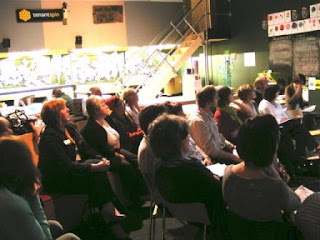
Deverra and LJMU ran another fantastic event at the Climate for Change experiment at FACT, Liverpool on May 18th.
 This day focused on gathering the views of health professionals on the need for change in Maternity room design and it had a great turnout with over thirty Midwives, Managers, Architects, Designers and students from around the North West.
This day focused on gathering the views of health professionals on the need for change in Maternity room design and it had a great turnout with over thirty Midwives, Managers, Architects, Designers and students from around the North West. The day sparked off lots of interesting debates and discussions and I will posting up some of the presentations, photographs, videos and feedback from the event in the next few weeks.
The day sparked off lots of interesting debates and discussions and I will posting up some of the presentations, photographs, videos and feedback from the event in the next few weeks. We then presented the work from the previous event and summarised some of the work we have been doing, looking at innovative maternity room design.
We then presented the work from the previous event and summarised some of the work we have been doing, looking at innovative maternity room design.
We showed a film with footage from the first 'A Space to give Birth in' event in March, both filmed and edited by Neringa Plange ( http://neringaplange.wordpress.com/)
We also had a presentation from the National CHildbirth Trust about their, 'Better Birth environment' campaign.
We had a really interesting talk from Aquabirths (http://www.aquabirths.co.uk/) about designing bespoke birthing pools and we were all inspired by their enthusiasm and the possibilities for new and exciting pools that could be used within UK maternity units.

 During lunch we had Gafro (http://www.gafro.com/GAFRO/HOME.html) a very talented percussionist, from the Liverpool Lark Lane Drummers group, run a workshop on African drumming, he introduced us to a rhythm which is used culturally to ease childbirth and I thought it was interesting to feel the mood change as the powerful, melodic music was heard throughout the FACT building, As we played, the music also depicted the changes of rhythm that women experience in Labour, from fast to slow, relaxed, to invigorated.
During lunch we had Gafro (http://www.gafro.com/GAFRO/HOME.html) a very talented percussionist, from the Liverpool Lark Lane Drummers group, run a workshop on African drumming, he introduced us to a rhythm which is used culturally to ease childbirth and I thought it was interesting to feel the mood change as the powerful, melodic music was heard throughout the FACT building, As we played, the music also depicted the changes of rhythm that women experience in Labour, from fast to slow, relaxed, to invigorated.
 It also reminded us, that for many women birthing for the first time, they are unsure, feel uncomfortable or they 'don't know how to do this' or lose their way (I think anyone joining in with the workshop could agree that we all lost the way rhythmically many times) but with a skilled and non judgemental facilitator (or musical midwife) we were able to rejoin the rhythm and enjoy the experience!
It also reminded us, that for many women birthing for the first time, they are unsure, feel uncomfortable or they 'don't know how to do this' or lose their way (I think anyone joining in with the workshop could agree that we all lost the way rhythmically many times) but with a skilled and non judgemental facilitator (or musical midwife) we were able to rejoin the rhythm and enjoy the experience! The findings from the discussion will be posted in the next few days, and make very interesting reading and have given us lots of ideas about ways to move this project forward.
The findings from the discussion will be posted in the next few days, and make very interesting reading and have given us lots of ideas about ways to move this project forward.

I found it very inspiring that the designs were implemented in a functioning hospital and are currently being used by labouring women in Cork, they are truly an example of innovative design!

Findings from the day will be published in the near future, and a second film produced from the footage of this second event (massive thanks to Marc Mcdermott http://services.creativecow.net/s/596/mcmedia for his filming)




